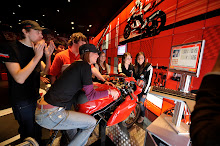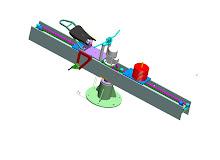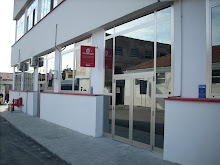Tutti sappiamo che le motociclette si muovono grazie alla spinta fornita dal motore. Ma come viene generata la spinta? Il motore nel suo funzionamento è paragonabile a un ciclista che pedala. All’interno del motore è presente un organo, l’albero motore, che è simile a dei pedali con la manovella molto corta. Su di esso sono collegati (attraverso le bielle) dei cursori, chiamati pistoni, che scorrono all’interno di vani cilindrici, i cilindri appunto.
La logica del funzionamento è semplice: si mette della benzina dentro il cilindro, col pistone che fa da coperchio; si accende la benzina con una scintilla in modo che lo scoppio generato spinga violentemente il pistone: quest’ultimo è vincolato all’albero motore e dunque dà una brusca pedalata, proprio come il ciclista sui pedali. Per dare un’altra pedalata occorre generare un’altra combustione: ogni scoppio corrisponde a una singola pedalata. Il motore può girare con regolarità solo se il pistone pedala ripetutamente sull’albero motore. Per fare ciò, dopo ogni ciclo ciascun cilindro deve essere svuotato dalla benzina bruciata e riempito di fresca, per consentire lo scoppio successivo.
Ciascun cilindro è raggiunto da due condotti: il condotto di aspirazione che porta la benzina necessaria alla combustione, e il condotto di scarico che permette di estrarre i gas generati durante la combustione. D’altra parte occorre che i condotti siano perfettamente chiusi durante la combustione della benzina, che altrimenti uscirebbe dal cilindro invece di spingere sul pistone, e che i condotti si aprano solo in momenti ben precisi, per consentire lo scarico dei gas e l’ingresso della benzina.
 L’apertura e la chiusura dei condotti sono regolate da valvole mosse da un sistema perfettamente sincronizzato con la posizione dell’albero motore e dei pistoni. Le valvole, concettualmente identiche a dei rubinetti, nei motori hanno la caratteristica forma a fungo. Esse si affacciano sul cilindro: per l’apertura del condotto sono spinte all’interno del cilindro mentre per la chiusura devono riposizionarsi indietro, in modo da fare tenuta sul foro che si affaccia sul condotto.Il movimento di apertura delle valvole in tutti i motori avviene grazie all’azione di un bilanciere, che come un dito spinge la valvola dentro il cilindro. La chiusura solitamente è ottenuta attraverso una molla che riporta la valvola in posizione di chiusura. Invece, nei motori Ducati, grazie al famoso sistema desmodromico sia l’apertura che la chiusura delle valvole sono ottenute attraverso la spinta di opportuni bilancieri.
L’apertura e la chiusura dei condotti sono regolate da valvole mosse da un sistema perfettamente sincronizzato con la posizione dell’albero motore e dei pistoni. Le valvole, concettualmente identiche a dei rubinetti, nei motori hanno la caratteristica forma a fungo. Esse si affacciano sul cilindro: per l’apertura del condotto sono spinte all’interno del cilindro mentre per la chiusura devono riposizionarsi indietro, in modo da fare tenuta sul foro che si affaccia sul condotto.Il movimento di apertura delle valvole in tutti i motori avviene grazie all’azione di un bilanciere, che come un dito spinge la valvola dentro il cilindro. La chiusura solitamente è ottenuta attraverso una molla che riporta la valvola in posizione di chiusura. Invece, nei motori Ducati, grazie al famoso sistema desmodromico sia l’apertura che la chiusura delle valvole sono ottenute attraverso la spinta di opportuni bilancieri.

Vi segnaliamo due video su You Tube che aiutano a capire il funzionamento del sistema di distribuzione desmodromico.
VIDEO 1
VIDEO 2
All'interno del laboratorio è possibile smontare e montare un desmo e capirne in maniera più approfondita il funzionamento.
What is the distribution and how does it work?
Everybody knows that motorcycles move thanks to the thrust provided by their engine. But the question is how to generate that thrust. The engine is similar to a pedalling cyclist. Inside the engine there is an element (the crankshaft) which is similar to short-cranked-pedals. Cursors (the pistons) are linked to the crankshaft through a linkage called piston rod. Pistons move inside a cylindrical element, the cylinder.
VIDEO
The functioning of the engine is simple: you put gasoline inside the cylinder, which is capped by the piston; a spark ignites the gas and the pressure generated by the combustion pushes hard the piston. The piston is linked to the crankshaft and so it provides it with a rotational thrust, just like the cyclist on the pedals. Every combustion corresponds to a single push on the crank, so if you want a regular rotation of the engine you need to provide it with regular thrusts. As a consequence, after every single combustion the cylinder must be emptied from the exhausts and filled again with gasoline mixed with air in order to prepare the next combustion.
Each cylinder is connected with two ducts: one for the fresh air and the other one for the exhausts. During the combustion, the ducts must be perfectly closed: they only open at precise moments, to let the exhausts exit from the combustion chamber and to make fresh mixture enter the cylinder.
The opening and closing operations of the ducts are regulated by valves moved by a mechanism that is perfectly synchronized with the position of the crankshaft and the pistons. Those mushroom-shaped valves (similar to taps in their functioning) are positioned on the top of the cylinders. They are pressed down inside the cylinder and the duct opens. Then they are pulled back to position to close the cylinder. In all the engines the opening action is executed by a swinging arm which presses the valve inside the cylinder, just like a finger on a button. The closing action is usually obtained through a very hard coil spring that constantly pushes on the valve. Differently, in all Ducati engines there is a swinging arm that presses the valve to open the duct and another swinging arm that pulls the valve to position, so that the entire movement is perfectly governed by a fixed law, even at very high speeds.































3 commenti:
Otra vez a visitarlos, el blog sigue tan interesante como siempre. Saludos.
I'm not sure exactly why but this site is loading very slow for me. Is anyone else having this problem or is it a problem on my end? I'll check back later on and see if the problem still exists.
Feel free to visit my blog cellulite treatment
davvero capire il soggetto !!
Posta un commento